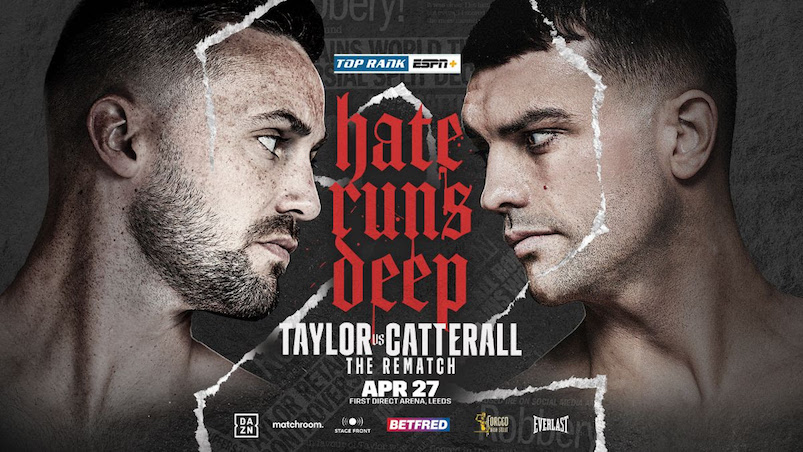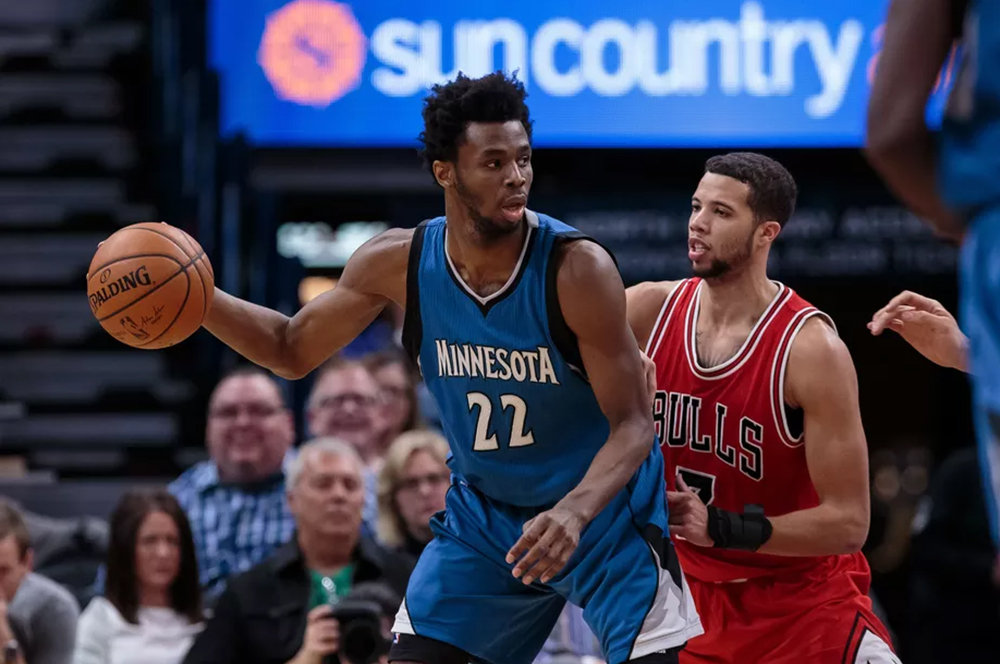Andrew Wiggins is eligible for a contract extension this summer, but has yet to get a deal
Most players chosen in the first round of the 2014 NBA Draft are eligible for contract extensions this summer. No one has yet inked a deal and it’s a mystery as to whether any of the big names will lock up long-term money this summer.
These players become restricted free agents in 2018 if no extension is reached by the end of October, and 2018 looks like a buyers’ market. Cap space is going to be fairly limited across the league. Even 2017 restricted free agents have gotten some raw deals — Nerlens Noel is still waiting on an offer.
If any eligible player is going to get an extension, it might be 2014 No. 1 pick Andrew Wiggins. He’s a workhorse on a rising club who isn’t quite a star, but has shown signs that the ability is in there. Wiggins is exactly the kind of player teams should want to lock into fat extensions. The problem is, he wants more.
Reports suggest that Wiggins believes he is worthy of the max contract — roughly $150 million over five years — and doesn’t intend to take less. That’s a huge chunk of the Timberwolves’ cap sheet for half a decade, especially given that Minnesota doesn’t yet know just how good it will be or how Wiggins will fit with Jimmy Butler.
Given the expected tight market in 2018 and the low risk of losing Wiggins in the immediate term over sour negotiations, the Timberwolves have the benefit of time. But in the end, should Wiggins be a max player for Minnesota? Let’s look at everything that goes into that question.
Is Andrew Wiggins good?
The most important piece of the equation is judging Wiggins’ on-court impact. This is trickier than one imagines. Wiggins is one of those highly controversial players whose numbers mean different things to different people.
He scored 23 points per game on 45 percent shooting this season as a 21-year-old. That’s pretty darn good! But how he scores is not quite in vogue, and he doesn’t do much else offensively to help your team. There’s a distinct early DeMar DeRozan vibe from Wiggins’ offense. (DeRozan has become a better passer and rim-attacker over time.)
It’s just as hard to judge Wiggins’ defense. This was one of his calling cards entering the league. He has the physical characteristics of a high-potential wing defender: speed, length, durability.
But Minnesota finished No. 29 in defensive efficiency overall (despite the presence of Karl-Anthony Towns and Ricky Rubio) and advanced defensive metrics like adjusted plus-minus grade Wiggins quite harshly. (ESPN’s version of adjusted plus-minus — RPM — graded Wiggins as the third worst rotation two-guard defensively in the league, ahead of only new teammate Jamal Crawford and Bojan Bogdanovic.)
Overall, the Wolves were much better with Wiggins on the floor than not. Wiggins and Towns played together for 32 minutes each game, per NBA.com. The Wolves won those minutes by an average of a half of a point. In the other 16 minutes per game — minutes where one or both of those players were on the bench — Minnesota gave up about 1.5 points per game more than they scored. A Towns-Wiggins battery was very slightly above average; the other Wolves (especially the bench) were subpar enough to erase all of that advantage.
It’s worth noting that the Wolves’ numbers with Wiggins on the floor and Towns sitting are somewhat better than with Towns on the floor and Wiggins sitting. Wiggins’ positive results overall do not appear to depend on Towns’ presence.
Given Wiggins’ low age and high production, it’s pretty clear that he’s good. While the numbers don’t back up the notion that he’s a star, he is far from a finished player.
What about the roster changes?
All of those numbers and that positive quantitative assessment of Wiggins came in an environment where Wiggins was the clear No. 2 option and top wing player on a fairly bad team. That’s not what he’ll be for the Timberwolves going forward.
With the trade for Jimmy Butler, Wiggins is bumped to a No. 3 option who will have the ball in his hands much less. In addition, Jeff Teague has traditionally been more ball-dominant than Rubio, who he replaces. That could also affect Wiggins’ offensive touches.
One imagines Butler will help the defensive end quite a bit — Wiggins no longer has to claim the opponent’s best wing every night — and a second year under Tom Thibodeau’s tutelage should be smoother. Teague isn’t a bad defender, but he’s a downgrade from Rubio on that end. The addition of Taj Gibson, another old Thibodeau hand, should help the defense, as well.
On offense and defense the new roster should take some pressure off Wiggins. The lessened quantity of responsibility should improve the quality and hopefully making him more efficient. But given that Wiggins’ value to date has largely been wrapped up in the quantity of his production, this shift may complicate further judgment!
The long-term outlook for Minnesota
The biggest question in all of this is how good a Butler-Towns-Wiggins-Teague team can be in the Western Conference. Some analysts are suggesting a low-end playoff berth is in the cards. Some are predicting an even better result.
The truth is likely somewhere in the middle: the Wolves don’t quite have the depth to hit 55 wins, but this isn’t merely a .500 team with Butler and the ascendant Towns. Given health and a reasonably smooth transition for Butler — who has the benefit of linking up with the coach under whom he found his stardom — the Wolves should find themselves in the 45- to 48-win range.
In terms of the salary cap sheet, the Wolves are already in a sticky situation. A max contract for Wiggins would put the 2018-19 Wolves near the expected luxury tax threshold without accounting for Nemanja Bjelica, who will be a restricted free agent in 2018.
Keep in mind that Towns is eligible for an extension next summer that would kick in for the 2019-20 season. Butler can opt out in 2019 and sign a fatter deal. Depending on cap growth and All-NBA berths, he could double his salary. This is all going to pinch Minnesota hard, especially if Glen Taylor remains the owner.
Taylor hasn’t paid luxury tax in a decade. In fairness, Minnesota has been mediocre or worse for more than a decade. There hasn’t really been an opportunity. But it’s unclear how much management will be willing to shell out given its market size.
Let’s point out that Wiggins’ contract isn’t by default the problem here, just as Towns’ contract wouldn’t be the problem in 2019. The $36 million committed to Gibson, Gorgui Dieng, and Cole Aldrich in 2018-19 is a much bigger deal — that’s a third of the salary cap sheet dedicated to rotation big men who can essentially never share the court. You can’t pay two Towns caddies and a back-up that much money when your young stars start to get paid at market rate.
Gibson and Aldrich come off the books before Towns’ new deal will kick in (barring extensions), but 2018-19 — with Wiggins’ pay raise — will be awful sticky. This situation also makes one raise an eyebrow at the Rubio trade followed by the Teague signing. Rubio was much, much more affordable than Teague, and quite possibly a better fit for the roster as a pass-first defender.
The Wolves’ options
Because of the advantages of restricted free agency, the Wolves don’t have to pay Wiggins this summer. Minnesota can play out the season and assess where the club fits in a top-heavy West. Perhaps some glaring hole (shooting?) will show itself, and the Wolves can consider the trade market for Wiggins at midseason.
The Kyrie Irving rumors continue to swirl given that player’s interest in joining Butler. There’s a chance that finding NBA team success for the first time in a winning season could convince Wiggins to keep the team together by taking a salary haircut. That doesn’t seem his style and frankly shouldn’t be encouraged for tax-saving purposes. But it’s possible.
There’s no rush here. The worst that can happen by waiting is for the Wolves to extend a max offer sheet to a somewhat annoyed Wiggins in July 2018, bringing him back at the salary he wanted all along. There are worse things. Chances are Wiggins gets his max deal one way or another, but there’s no impetus on the Wolves to lock it in now.
If a truly blockbuster deal — for Irving or someone else — comes along in the meantime, the flexibility may be worth having.



